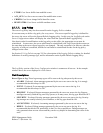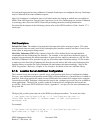5.1.1.2. Interface Controls
The Interface Controls section of the Server Configuration window is common to all servers. In the
example window above, the server displayed is a Core Server.
Field Descriptions
Maximum Connections. The maximum number of clients that this server can service at one time. This
value should be set based on the anticipated number of concurrent clients. Too large a value may slow
down the system. Too small a value will mean that some clients are not able to connect.
Thread Pool Size. The number of threads this server spawns to handle client requests. If necessary, the
default values can be changed when defining servers. Too large a value may consume server memory for
no purpose. Too small a value could mean that some client connections don't get serviced in a timely
manner. The Thread Pool Size should be equal to or larger than the value used for Maximum
Connections.
Request Queue Size. The maximum number of requests that can be queued waiting for request threads.
If the workload increases so that this value is exceeded, requests will be rejected by the server rather than
queued for processing. A value of zero means to use the default queue size of 20.
Note: See Section 3.1.2: Tuning the System Manager RPC Thread Pool and Request Queue Sizes on page
31 for information on tuning the RPC thread pool and request queue sizes for the System Manager.
Interfaces. The information required for the server to communicate with other HPSS servers and clients
over the HPSS RPC network interface. Each server type is configured with one or more interfaces. With
the exception of the Authentication Mechanisms, the administrator cannot override the default values for
each interface when creating or modifying a server configuration. Each interface consists of the
following fields:
Interface Name. The descriptive name of the interface.
Interface Id. The UUID that identifies this interface.
Interface Version. The interface version number.
Authentication Mechanisms. The authentication mechanisms from which the interface will
accept credentials. One or both of the mechanisms can be checked (at least one should be
checked or that interface will be unusable). Each interface supports the following authentication
mechanisms:
• KRB5 - indicates that the interface will support Kerberos 5 authentication
• UNIX - indicates that the interface will support UNIX authentication
5.1.1.1. Security Controls
The Security Controls fields define the settings for authenticated communication between the server and
other HPSS servers and clients.
HPSS Management Guide November 2009
Release 7.3 (Revision 1.0) 92


















